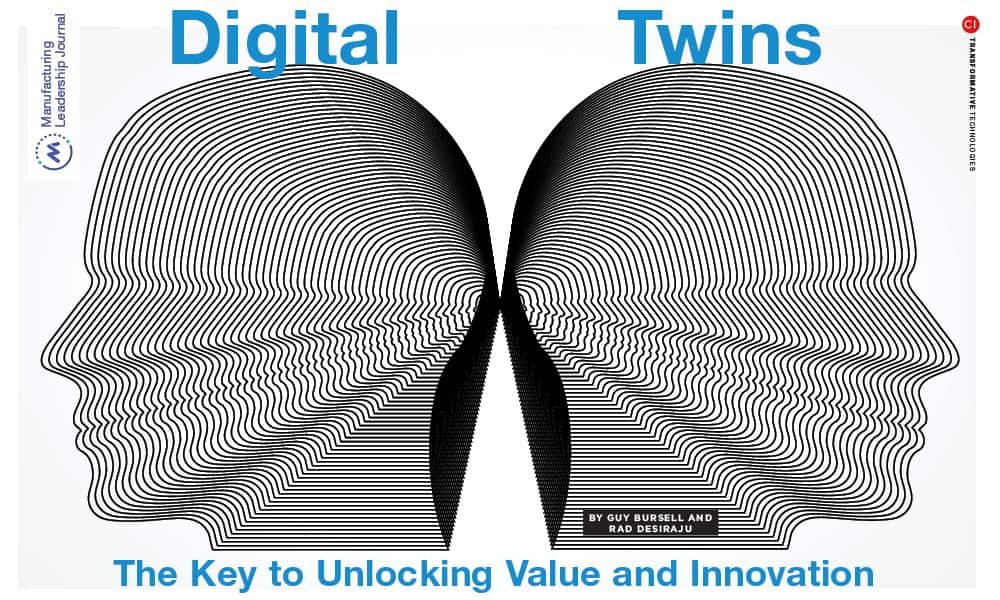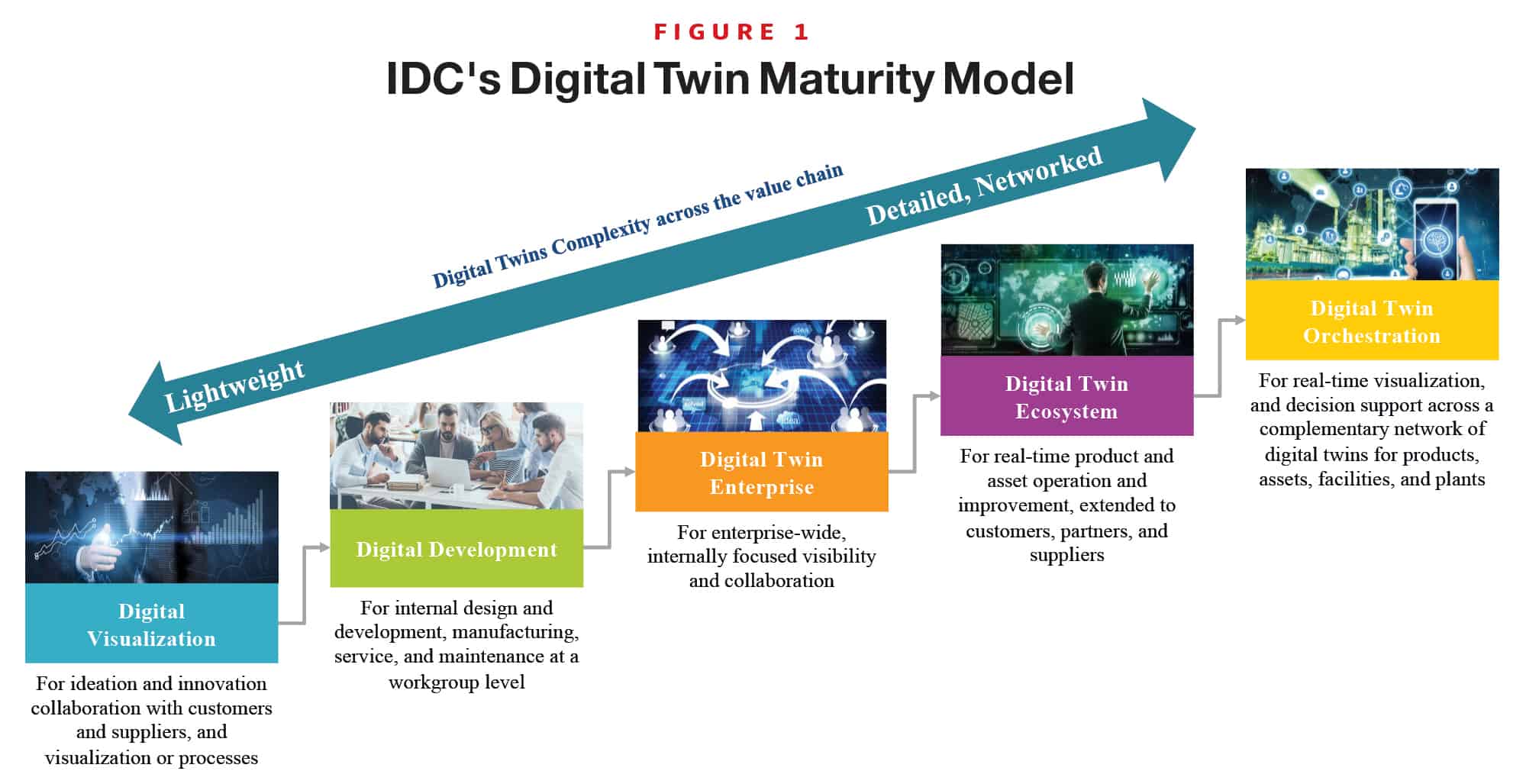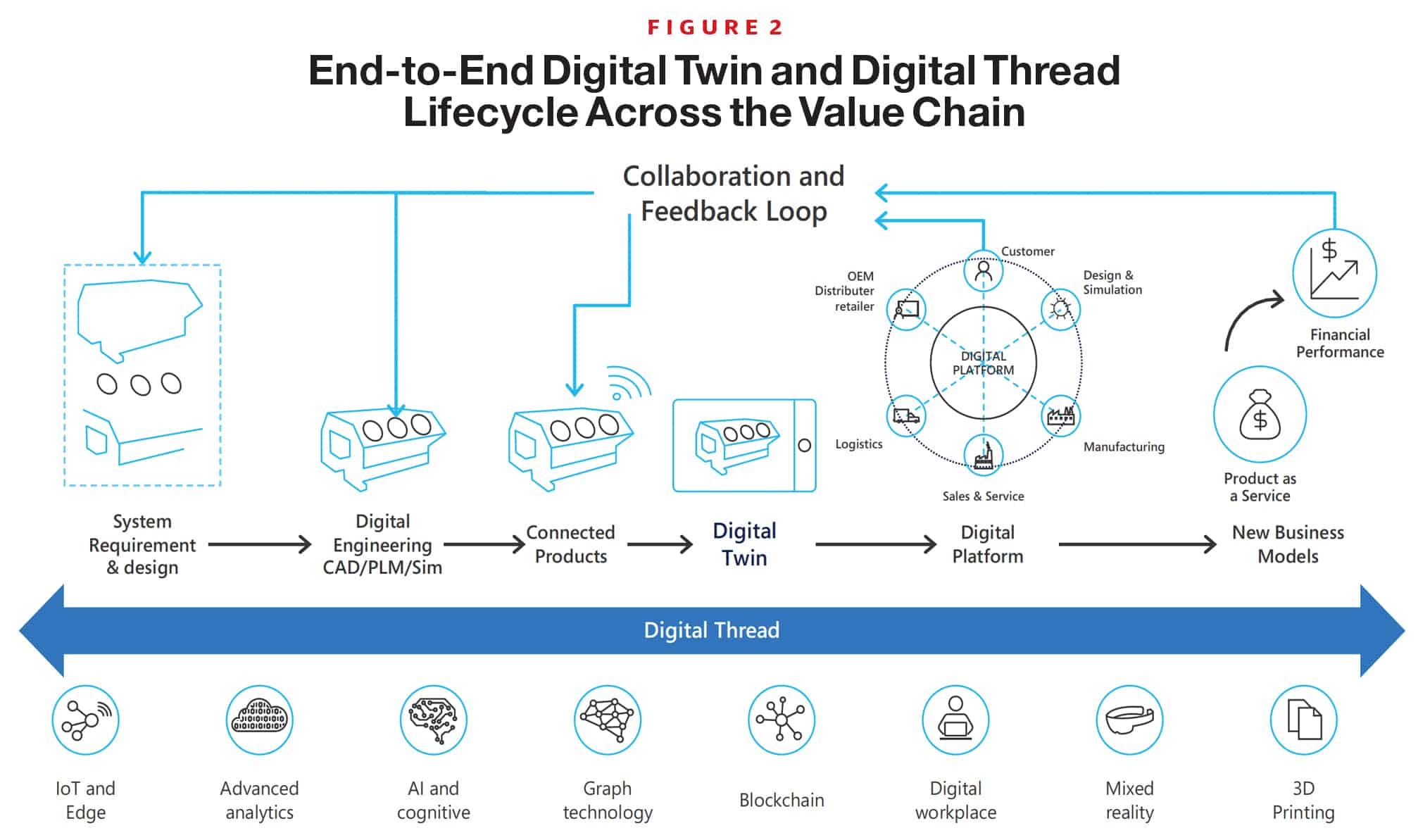Digital Twins: The Key to Unlocking Value and Innovation

By turning the physical into the computable, manufacturers can reach new heights in visibility, performance, and business value.

As decision-makers in manufacturing embrace digital transformation to improve business visibility, increase asset and product reliability, optimize operations, and unlock new business models and revenue streams, it is imperative to consider a digital twin as a key piece of this transformation. A connected, virtual replica of a physical product, asset, or system, digital twins turn the physical world into computable objects.
Digital twins live in the present but learn from the past to predict future states and create new opportunities and insights to perform rewind, replay of product or asset operations, and get answers to “what if” questions all in the digital world.
Digital twins provide a way to combine technologies, such as streaming sensor data with IoT, advanced data analytics, and machine learning to enable a knowledge graph representation of the world. Although most of the technologies already exist as stand-alone capabilities, digital twins provide a common framework to bring them together and more rapidly innovate.
The digital twin is based on massive, cumulative, real-time, real-world data measurements across an almost endless array of dimensions. These measurements can create an evolving profile of the object or process in the digital world that can provide important insights on system performance, leading to actions in the physical world such as a change in product design or manufacturing process.
Agility Across the Value Chain
During the design and development phase, digital twins allow optimal decisions for design alternatives and system properties. They also help to ensure the best usage and performance and to realize advanced service or maintenance solutions of an industrial asset or product. They even support end-of-life-management such as for airframe service time life or a gas turbine MTBF. This means a digital twin can accompany an industrial product over the whole lifecycle, seamlessly linking all stages of the value chain. All the data collected during its lifecycle can inform the design, production, operation, and use for the next generation of a product.
As products and systems increase in complexity, almost all industrial or technical products will come with such a digital twin, enabling detailed simulations and their management over the whole lifecycle. They start as twins of a product type with the original design information, engineering models, and testing data. They continue after manufacturing as representations of specific instances of a product using the data collected during operation to support maintenance and service along with other activities. And finally, the digital twin helps facilitate end-of-life-usage and product obsolescence, which could help a circular economy.
IDC research outlines a Digital Twin Maturity Model1 (Figure 1) that begins with digital visualization and moves through digital development, digital enterprise, digital ecosystem, and finally digital twin orchestration. Digital twin technologies can have a positive impact on management and operations across the entire value chain, moving from ideation and visualization of processes to service and management at a greater scale.

In manufacturing today, there is a focus on the operational phase of products and assets, allowing for digital twins to be adjusted when the real product gets modified. Another focus area is using simulations to predict the need for maintenance and service. This allows for better product service, product quality, time and cost savings, and unprecedented flexibility for operations. A digital twin as a synchronous image of a system in operation enables advanced solutions like extended monitoring, simulation of changes, and simplified control. Since production in nearly all industries is required to be flexible, these digital twins will also support real-time adjustments during operation.
For any industrial product to come to life it must pass through several stages that often are only loosely interconnected today in a digital sense: from data in the design and development phase to manufacturing, implementation, operation, end-of-life, and recycling. Digital twins in conjunction with digital threads have the potential to build connectivity within and between different business processes such as product lifecycle management, manufacturing planning and execution or supply chain management.
Key Considerations for Digital Twins
It is important to note that digital twins are not complete representations of a product – they are made up of various models and data for specific outcomes and apply suitable precision for the required solution. Another important distinction is the difference between a digital twin representing an asset type – the information of which may be in the cloud – and its instances, which are additionally characterized by operational data, its operational context, technical configurations, and environmental parameters.
Key to the digital twin is focus on the various information and data points needed at various stages across the lifecycle of the product. It is important to structure data in a reusable way, typically through a canonical data model, which is a common, enterprise-standard data structure that enables different systems and applications to connect and exchange enterprise information. A canonical structure can allow various systems to communicate in a simple agreed-upon framework. This can reduce the amount of data that must be stored outside of the systems of record, eliminate the need to manage large master data structures, and allow a company to use the digital twin in multiple ways with more flexibility, with continual updates as it is integrated further within the enterprise.

Arguably the most important enabler for digital twins are digital threads, which is a communication framework that links all elements of a product’s data, from design to obsolescence. Harnessing the enormous amount of data in the product lifecycle with digital threads reduces the complexity of implementing digital twins and increases their accuracy. Manufacturers start by implementing digital threads that make sense for them, or incrementally drive specific outcomes without having to undertake massive investments to develop a holistic digital thread up front.
Benefitting from the insights that digital threads provide is only possible if data is accurately identified, classified, and correlated across the various sources it resides in. Relevant security and access controls must also be applied to data delivered across internal and external applications. A critical success factor for digital twin deployment is this transparent and automated information-identification processing, especially in distributed enterprises such as aerospace and defense organizations and highly regulated industries such as medical devices.
For digital twins to fully realize their potential it is important that they have an open format, allowing it to be easily updated, scaled, and extended when new models and data representing new outcomes is added. Communication modules ensure a secure and stable connection to the assets or other integration services. For modern open protocols like OPC UA, MTConnect, and MQTT there are already various modules available, whereas proprietary protocols require vendor-specific communication modules. Additionally, communication modules actively connected to the cloud are a vital feature of the edge level.
Additional modules handle other functions that are necessary for an integrated solution: buffering, filtering, distribution of the messages to further endpoints, or other edge modules (e.g., AI modules), and preprocessing (e.g., message enrichment). The edge layer can run complex logic modules and act as a recipient of trained or updated machine learning models, applying the new logic to incoming data and making determinations from it. Device management modules for monitoring, updating, or security activities on the device are essential to managing large-scale edge ecosystems.

Digital twins can have a positive impact across the entire value chain, moving from ideation and visualization of processes to service and management at a greater scale.
Standards facilitate an efficient use of digital twins, and this in turn enables the creation of economic value. To date, there are no genuine standards developed solely for digital twins. The reason for this is that digital twins are still created within the context of established standards in different domains, such as the automotive, industrial machinery, or aerospace industries; different disciplines such as mechanical, electrical engineering, or software; or with respect to specific uses or outcomes, be it testing, production, or maintenance
Leveraging cloud-based computing, storage, analytics, and AI/ML services which are secure, feature-rich, and highly scalable from anywhere in the world provide a unique advantage in building digital twins. In today’s globally integrated networks of factories and supply chains, these features enable OT and IT managers to build, deploy, and grow solutions quickly and at low costs. These efficiencies are coupled with the tradeoff of control or freedom. Careful architectural planning (e.g., defining a business domain model) and the application of cloud principles, such as containerization, enables manufacturers to realize the benefits while minimizing the tradeoffs.
As the digital twins evolve in such a manner, they morph into continuously newer evolutions of the digital twin. Cost is obviously a concern – digital twins will only be widespread if they have a positive benefit-cost-ratio. And while today a digital twin may be still expensive to build and maintain, the technical and economic advantages they enable will help with scaling so that digital twins will become more commonly incorporated in industrial business models.
Achieving Success through Increasing Value
True success in achieving early milestones on a digital twin journey rely on an ability to grow and sustain the digital twin initiative in a fashion that can demonstrate increasing value for the enterprise over time. To help ensure such an outcome, one may need to integrate digital technologies and the digital twin into the complete organizational structure — from R&D to sales and field service — continuously leveraging digital twin insights to change how the company conducts business, makes decisions, and creates new revenue streams.
Developing a digital twin strategy always begins with the intended business outcomes and impact on people, practices, technologies, and processes. Often many digital strategies fail to meet expectations because they are focused on proof-of-technology vs. proof-of-value. Once value is well articulated, the technology can be proven through use cases with measurable results.
As an example, if the goal of a digital twin strategy is to increase equipment availability in the field, the scope of the use case can span equipment health insights through to optimal scheduling of parts and field engineers. The KPIs can then take the form of total service availability by the number of maintenance incidents mitigated, elapsed time for replacement part availability, product enhancements with digital services through OTA updates, and reduction in time taken to deploy resources in the field.
With the large adoption of 5G wireless network, edge connectivity gets a major boost in terms of data transfer and bandwidth. The 5G core network controls the data flows and connections between the 5G device endpoint and the data network endpoint (the user plane functions or UPFs). The 5G system is able to communicate the network’s status and events and obtain configurations from outside via a standardized API.

“Data management is an important function that needs to be operationalized and
included in regular processes.”
The approach to this use case can be the analysis of equipment telemetry such as onboard diagnostics or analytical processing of historical performance data but represented as a relative health measurement easily identifiable by a field engineer. This representation could be purely data driven and displayed through a dashboard or a holographic indicator shown within the context of the actual equipment as it operates.
The manifestation of value can also be the creation of a customer-facing digital twin service that manages availability of their equipment through automated insights and expert assistance from the manufacturer. As manufacturers bring in this kind of intelligence, they can drive significant levels of growth and efficiency across the organization by:
- Personalized service. Real-time data shows how your customers are operating and maintaining their products. This has the potential to completely change customer experience and support to more personalized service vs. a one-size-fits-all approach. New value-added digital services and revenue streams also become possible. They can extend capabilities such as customer support and field service, as well as develop upgradable opportunities tailored for optimal performance of specific equipment.
- Driving product quality and innovation. Digital twin simulations allow manufacturers to experiment with design iterations, make more informed design and engineering decisions, and enhance the overall product roadmap. This data allows for influence and validation of digital prototypes while also bringing more innovative products to market faster.
- Preventing breakdowns before they occur. Digital twin simulations can be used to adjust product performance, safely postpone non-regulated maintenance events, or even eliminate problems before they occur. Service technicians can manipulate equipment digitally in real-time or visualize problems ahead of a job to optimize operation and perform preventative maintenance – solving problems before they come to pass.
- Reinventing knowledge-sharing for employees. Digital twins can allow experts to explain complex scenarios visually, with 3D and 2D representations of real-world operational parameters and characteristics. These tools are essential for manufacturers to democratize skills and knowledge-sharing when facing an aging workforce and an approaching skills gap between new or less experienced employees. A digital twin strategy also enables employees in both professional and trade roles to build skills, creating new possibilities through advanced and contextual knowledge sharing.
Better Outcomes with Smarter Decisions
Implementing a digital twin strategy allows manufacturers to fix products and processes faster, which in turn means equipment stays working longer. Manufacturers can develop higher quality products with a more efficient workforce. The key is the ability to use real-world operational data to make smart, informed decisions that provide the best resolution.
Going forward, digital twin strategy will be non-negotiable for most manufacturers. As the foundation for connected products and services, it is a critical path to enabling asset or process lifecycle management, collaboration, flexible vertical integration, and end-to-end reengineering. To be truly successful, companies must thread digital twin capabilities into the value chain as a strategic asset to enable new opportunities and provide market differentiation. The digital twin strategy is more than just about technology. No longer is it an IT or engineering overhead for organizations; it is a powerful business strategy that can accelerate digital transformation. M
Footnotes:
1 IDC, Digital Twins and Digital Thread for Engineering and Operations, Doc # US47453021, February 2021